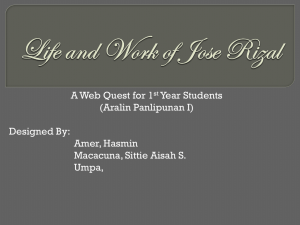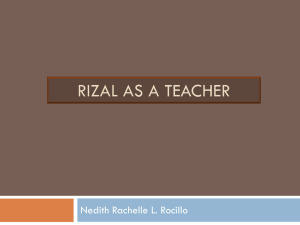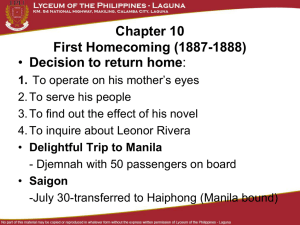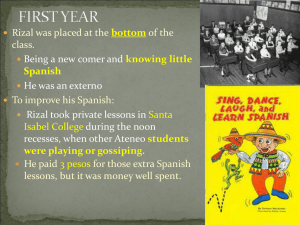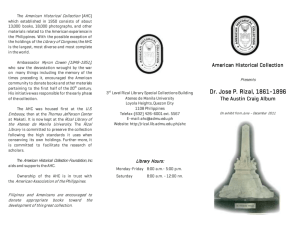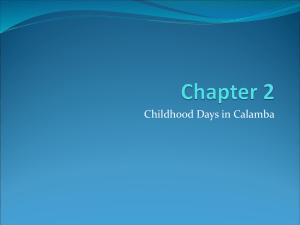JOSE RIZAL AND SUEHIRO TETCHO - Asian Studies | Journal of
advertisement
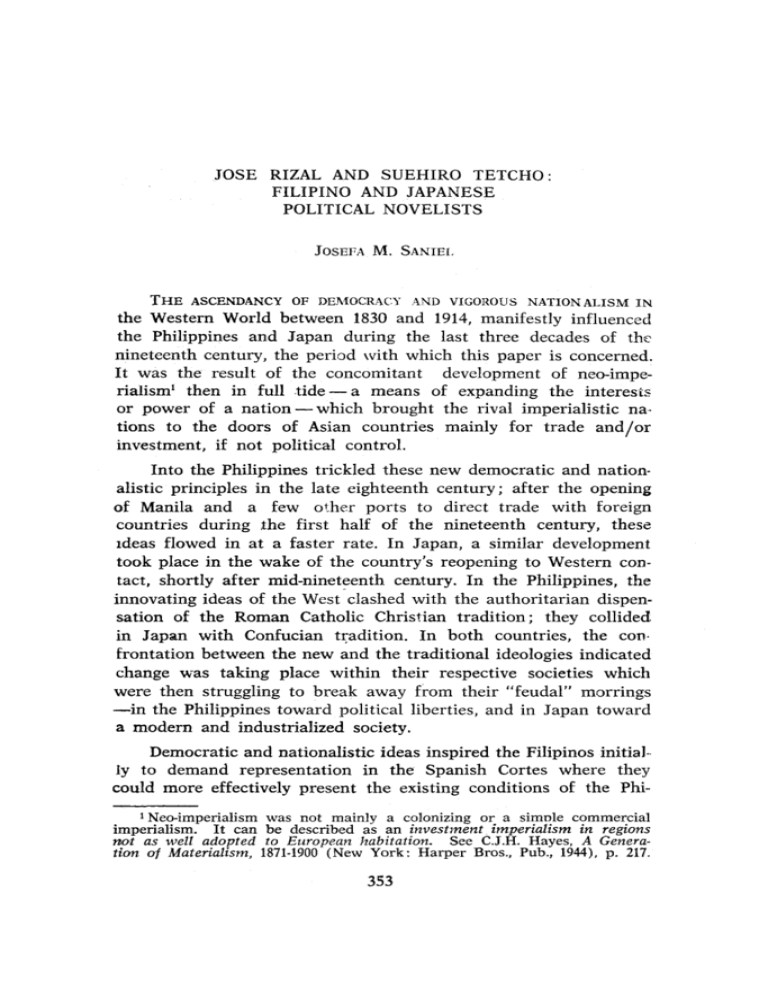
JOSE RIZAL AND SUEHIRO TETCHO: FILIPINO AND JAPANESE POLITICAL NOVELISTS JOSEFA M. SANIEL THE ASCENDANCY OF DEMOCRACY .AND VIGOROUS NATION ALISM IN the Western World between 1830 and 1914, manifestly influenced the Philippines and Japan during the last three decades of the nineteenth century, the period with which this paper is concerned. It was the result of the concomitant development of neo-imperialism' then in full tide - a means of expanding the interests or power of a nation - which brought the rival imperialistic nations to the doors of Asian countries mainly for trade and/or investment, if not political control. Into the Philippines trickled these new democratic and nationalistic principles in the late eighteenth century; after the opening of Manila and a few other ports to direct trade with foreign countries during the first half of the nineteenth century, these Ideas flowed in at a faster rate. In Japan, a similar development took place in the wake of the country's reopening to Western contact, shortly after mid-nineteenth century. In the Philippines, the innovating ideas of the West clashed with the authoritarian dispensation of the Roman Catholic Christian tradition; they collided in Japan with Confucian tradition. In both countries, the con· frontation between the new and the traditional ideologies indicated change was taking place within their respective societies which were then struggling to break away from their "feudal" morrings -in the Philippines toward political liberties, and in Japan toward a modern and industrialized society. Democratic and nationalistic ideas inspired the Filipinos initially to demand representation in the Spanish Cortes where they could more effectively present the existing conditions of the Phi! Neo-imperialism was not mainly a colonizing or a simnle commercial imperialism. It can be described as an investment imperialism in regions not as well adopted to European habitation. See C.J.H. Hayes, A Generation of Materialism, 1871-1900 (New York: Harper Bros., Pub., 1944), p. 217. 353 354 ASIAN STUDIES lippines which called for reforms. The abuses of the colonial and church officials; the lack of educational facilities and opportunities for the Filipinos; the absence of technical and financial assistance to the farmers constituting the base of the country's population; the need for guarantees of individual rights and of increasing the means of transportation and communication and '>0 forth, exemplified such deplorable conditions. The Filipino nationalists had hoped that if these social ills were rectified, they could help in strengthening the feeling of nationhood among the people.' The aforementioned Western ideas, on the other hand, motivated the Meiji period Japanese nationalists to clamor for a constitution and the establishment of a parliament - objectives which perhaps they could not fully comprehend but which they knew of and desired because they linked them with "the new and wonderful West" - independence, freedom, equal rights. When, in 1890, the constitution and the parliament became realities within the Japanese scene, these ideas from the West prompted a more enthusiastic agitation for expansion to neighboring areas of Asia. There, the Japanese nationalist-activists had claimed they would pursue minken or the "people's rights," especially in countries of Asia where corruption, inefficiency, and weakness of government were apparent, or where - as in the Philippines - the colonizers were repressive and oppressive.' It should be pointed out that although Japan and the Philippines felt the impact of nineteenth century democratic and nationalistic ideas, these ideas were responded to differently by the Japanese and the Filipinos, as indicated above. Consequently, in each country, nationalism developed along different lines; the resulting changes in each society were different. In both countries - the Philippines and Japan - the impact of democratic and nationalistic teachings was initially felt by the literate or thinking people and when their individual rights were circumscribed by repressive laws, they tended to articulate their feelings of discontent and to register their objections to existing social conditions in political novels. Thus, this genre of writing served not only as a safety valve for the author's suppressed 2 See, for instance, Rizal's program of reforms in R. Palma, The Pride of the Malay Race, trans. by R. Ozaeta (New York: Prentice Hall, Inc., 1949) pp. 226-227. 3 See Chapters III and IV of J.M. Saniel, Japan and the Philippines, 18681898 (Quezon City: University of the Philippines, 1963). JOSE RIZAL AND SUEHIRO TETCHO 355 feelings but also as a vehicle of his political opinions, as well as the most important medium for portraying the existing sociopolitico-economic conditions of his society. I shall deal with two late-nineteenth-century political novelists of Asia and one each of their novels: Jose Rizal and his Noli Me Tangere; Suehiro Tetcho and his Nanyo no daiharan (The Severe Disturbance [lit., Great Wave] in the South Seas)," The lives of these two novelists and their works reveal the influence of democratic and nationalistic teachings then prevailing in the Western World. Let us, therefore, note the pertinent parts of Rizal's and Suehiro's biographies as well as the two novels, and then attempt to indicate the influence of Jose Rizal and his Noli Me Tangere upon Suehiro Tetcho and his Nanyo no daiharan which Suehiro impliedly acknowledged at the beginning of his novel. I Born on June 19, 1861- the seventh child of Francisco Rizal and Teodora Alonzo - Jose Rizal spent his early life in Calamba, Laguna, in circumstances that even in the Philippines then and now must be considered privileged.' After having been taught by his mother and two tutors, and having spent a year in Calamba's public school, Jose Rizal entered the Ateneo in 1872. He distinguished himself in literature and in 1877, earned the degree of Bachelor of Arts (with highest honors) and then briefly studied surveying before enrolling in the same year for philosophy and medicine at the University of Santo Tomas. Between 1877 and 1882 when Rizal departed for Europe (leaving behind a lady-love, Leonor Rivera, who is said to be Rizal's Maria Clara in his Noli Me Tangere), he won local prizes for such literary works as his poem .4 La Juventud Filipino (To the Filipino Youth) and his allegorical composition, El Consejo de los Dioses (The Council of the gods). 4 (Tokyo: Sumyodo, 1891). After Nanyo no daiharan, Suehiro Tetcho wrote two other political novels dealing with the Philippines. They are: (1) Arashi no nagori (The Aftermath of a Storm) which is a sequel of the first novel; (2) Oumabara (Ocean [lit., A Vast Expanse of Water]). See Yanagida Izumi, "Suehiro Tetcho Kenkyu" (A Study of Suehiro Tetcho), II, Seijishosetsu (Tokyo: Shunjusha, 1935), pp. 584-589. S For a biography of Jose Rizal, read the prize-winning book: L. Ma. Guerrero, The First Filipino. .4 Biography of Jose Rizal (Manila: Jose Rizal National Centennial Commission, 1963). See also a chronology of Jose Rizal's life in N. Zafra, "Readings in Philippine History" (mimeographed; Quezon City: University of the Philippines, 1956), Vol. II, pp. 551-558. 356 ASIAN STUDIES Arriving in Barcelona in June 1882, Rizal continued writing while enrolled in Madrid's Universidad Central where he took courses in medicine, philosophy and letters. The year he started writing his first political novel- the Noli Me Tangere - in the early 1880's, he went to Paris to undertake special training in ophthalmology' and to improve his knowledge of the French language. In Paris, he started communicating with his friend, the Austrian scholar Ferdinand Blumentritt,' and completed his Noli Me Tangere which he published in Berlin in 1887, with Dr. Viola's financial assistance. Rizal returned to Manila from Europe early in July of the same year, arnvmg on August 6 in the Philippine capital where the incumbent Governor and Captain General E. Terrero assigned a lieutenant of the civil guard as his escort. The following February, Rizal cut short his sojourn in his country and left for Japan where he spent forty-six days and met Osei-san" about whom Rizal wrote in his dairy: "No woman has ever loved me like you."? In April, 1888, he departed on the Belgic bound for Europe (via the United States). Back in Spain, he contributed to the Filipino propaganda organ, La Solidaridad, as well as wrote and published in 1891 the El Filibusterismo, the sequel of his first novel. On October of the same year (1891), Rizalleft for Hong Kong, arriving there late the following month. There, he learned of the deportation to Hong Kong from Calamba of some members of his family. In June of the following year, Rizal decided to return to Manila. Soon after founding in July La Liga Filipina which aimed at working for reforms in the Philippines, he was exiled to Dapitan, in northwestern Mindanao and remained there for four years (J uly 1892-July 1896). Rizal left Dapitan when his offer to serve as a medical doctor in the Cuban revolution was accepted 6 For an account on Jose Rizal as an ophthalmic surgeon, see G. De Ocampo, Dr. Rizai, Ophthalmic surgeon (Manila: Philippine Graphic Arts, Inc., 1962). 7 On Rizal's interesting exchanges of ideas and news with F. Blumentritt, see Epistolario Rizalino (Manila: Bureau of Printing, 1931-1938), Vols. II-V, et passim. 8 Her real name was Usui Seiko, a daughter of a hatamoto who could speak English. She was Rizal's guide during his short stop-over in Japan. Data gathered from an interview with Mr. Hashimoto Motomo who had boarded with Usui Seiko, later educated at Waseda University and became the editor of the Kodansha. Tokyo, Japan, September 11, 1960. 9 See quoted part of Rizal's diary in C. Ouirino, The Great Malayan (Manila: Philippine Education Co., 1940), pp. 145-146. JOSE RIZAL AND SUEHIRO T'ETCHO 357 by the Spanish Governor and Captain General Blanco. But having been implicated in the outbreak of the Philippine Revolution (on August 19, 1896) led by members of the secret society - the Katipunan. - Rizal was made to return to Manila even before he could reach Cuba. From the time he arrived in Manila (on November 20) to his death before a firing squad (on December 30), following a farcical trial for sedition by a military court, Jose Rizal was confined at Fort Santiago where he wrote his final contribution to Philippine literature - his famous "Last Farewell.':" now translated into a number of Asian and Western languages. This poem reveals Rizal's love of country and his democratic as well as nationalistic ideas which are also expressed in the writings of his Japanese contemporary - Suehiro Tetcho - whose biography we shall now consider. Born to a samurai family, four years before Commodore Perry arrived in Japan in 1853, Suehiro Tetcho" was twelve years older than Jose Rizal. His early life at Uwajima (now in Ehime Prefecture) in the island of Shikoku (then under a progressive and intelligent Lord Date) witnessed the reopening of Japan to the Western World as well as the 1868 Meiji Restoration. A young man at the time of the Restoration, he was appointed teacher at a clan school, after studying the life and Neo-Confucian teachings of Chu Hsi in a school established by Lord Date. But even as a student, Suehiro was a deviant: he preferred to read and study secretly the books of Ming China's Wang Yangming who questioned Sung China's Chu Hsi's Nee-Confucian stand and whose followers in Japan were grouped into a school of thought called Oyomei, Although he was punished for reading Wang Yangming, he decided in 1870 to continue studying Wang's teachings in Kyoto after a brief stint in Tokyo as a pupil of Hayashi Kakuryo, earlier that year. Two years later, Suehiro returned to his home town and was appointed to a minor government position from which he resigned the following year, for another minor position in the Ministry of Finance at Tokyo. 10 For the original in Spanish of Rizal's "Last Farewell," see Guerrero, op. cit., pp. 481-482. 11 For a brief biography and summary of Suehiro Tetcho's political novels, see Yanagida Izumi, Seijishasetsu Kenkyu, op, cit.; pp, 387-651. For glimpses of Suehiro's biography, see also Kimura Ki, "Jose Rizal's Influence on Japanese Literature," (typescript) and Col. N. Jimbo, "Rizal and Suehiro Tetcho," Historical Bulletin, Vol. VI. No. 2 (Manila: The Philippine Historical Association, June, 1962), pp. 181-182. 358 ASIAN STUDIES Two years later (1875), when the "civil rights" or the "people's rights" movement was gaining national proportion," Suehiro joined the Akebono (Dawn) as its Chief Editor. Before the year ended, however, he moved as Chief Editor to another newspaper, the Choya Shimbun (Government and the People), because of Akebono's increasingly conciliatory attitude towards government polio cies. It must be added that both papers gained reputation for their bold and candid reporting. As a result, Suehiro became a popular figure, especially because he was among the first of the journalists charged, fined and imprisoned (he was imprisoned twice) under the Press Law of 1875.0 It is said that while he was in prison, he learned English. By 1881, without resigning from the editorship of Choya Shimbun, Suehiro joined the first Japanese political party - the Jiyuto - established in Japan by his clansman, Itagaki Taisuke. After withdrawing from the Jiyuto in 1883 (again due to the conciliatory stand towards the government of the party's leaders) and taking off for over a year from his journalistic activities because of failing health, Suehiro returned in 1886 to the Iiyuto fold and enthusiastically cooperated in reorganizing it. At about this time, he wrote two novels which turned out to be best sellers: "Plum BIos soms in the Snow" and "A Nightingale Among Blossoms." The first one, according to Sansom, went through several editions and more than three hundred thousand copies were sold." It is needless to mention that the two books expressed the desires for a constitution, a parliament and guarantees of individual rights of Suehiro and those who were working in the "people's rights" movement. As a result of the unexpected income from his books, Suehiro decided to make a trip to the United States and Europe in April 1888, returning to his country only in February of the following year, shortly after the Japanese Emperor had granted his people a constitution. In the same year - perhaps to raise funds for his election campaign - Suehiro published the record of his travels 12 See Chapter VI of N. Ike, The Beginnings of Political Democracy in Japan (Baltimore: The Johns Hopkins Press, 1950), pp. 60-71. See also Chapter VI of H. Borton, Japan's Modern Century (New York: The Ronald Press Co., 1955), pp. 93-110. 13 The Press Law was passed at the time the debate raged between the "liberals" and the government on the question of liberty and rights for the people. This law gave the Meiji government extensive powers of control. See Borton, op. cit., p. 185. 14G. Sansom, The Western World and Japan (New York: Alfred Knopf, 1958), p. 415 JOSE RIZAL AND SUEHIRO TETCHO 359 in two books entitled The Travels of a Deaf-Mute and Memoirs of my Travels, in which he described his meeting and friendship with Jose Rizal. He won a seat in the first House of Representatives of the Japanese Diet which was established in 1890. The following year, he published a novel, the N anyo no Daiharan, followed later by its sequels - Arashi no nagori and Oumabara - all dealing with Japanese aspirations to help the Philippines gain her independence from Spain and then to extend Japanese protection over the Islands." After two election defeats - in 1892 and in 1894, and a trip to Siberia and northern China to study conditions there - he was again elected to the House of Representatives in May 1895, immediately following a neck cancer operation which temporarily restored him to health. He was well enough in June to vocally participate in opposing the demands presented by the countries involved in the "triple intervention," and in August, to help in organizing a new party - the Doshikai. Soon after, his health continued to fail until his death in February 1896 (the year Jose Rizal was shot to death), fighting to the end for his "people's rights" and for the enhancement - through expansion - of the greatness of the Japanese state then taken as coterminus with the Emperor." Comparing the biographies of Jose Rizal and Suehiro Tetcho, both of whom came from well-to-do families and who had gone abroad to see for themselves the developments in the West, we note that both persons could be considered as belonging to the intelligentsia and/or the pioneering reformers of their respective societies. Especially within a transitional society, this group of people - the intelligentsia - is usually the first to feel the impact of ideological innovations (such as the democratic and na(like Jose Rizal and Suehiro Tetcho did in their novels). Being tionalistic ideas of· the nineteenth century) and react to them of the intelligentsia and of affluent families, Rizal and Suehiro portrayed in their novels the undesirable conditions within their respective societies, and the reaction of their "advanced" social group. 15 See 16 For footnote 2, supra, concerning these novels. further explanation of the equation of the Emperor and the State, see J.M. Saniel, "The Mobilization of Traditional Values in the Modernization of Japan" (mimeographed), paper read at the International Conference of the Congress for Cultural Freedom, June 3-9, 1963. 360 ASIAN STUDIES Though both Rizal and Suehiro actively articulated their opinions about their societies in their writings, Rizal wrote his major political works away from his homeland while Suehiro wielded his pen and tongue at. home. Therefore, Suehiro was more deeply involved in national politics while Rizal could only view political developments in his country and comment about them from a distance-s- in Europe. Yet, both found themselves in prison - Rizal for charges of sedition and Suehiro for violating the 1875 Press Laws. Further, more, Rizal was exiled for four years in Dapitan, thus preventing him in either leading - for instance, the Liga Filipina, which he founded before he was banished to Dapitan - or actively participating in any reform movement. It must be pointed out, however, that in Dapitan, he used his training and scientific knowledge to undertake projects which objectified the ideas he verbalized in his writings: advancing his people's lot through the suitable kind of education, improved agricultural methods and respect for human dignity." Rizal died before a firing squad while Suehiro died a natural death, though both of them worked to the end for the attainment of democratic and nationalistic ideals which had largely inspired as well as motivated them during their lifetime. Now, let us briefly consider how Jose Rizal's Noli Me Tangere and Suehiro Tetcho's Nanyo no Daiharan reveal their respective interpretations of democratic and nationalistic ideas by a summary of each of the novels, written each within a decade from their passing. II The Noli Me Tangere narrates the ill-starred love of Crisostomo Ibarra and Maria Clara, both having some Spanish forebears, and the only child of wealthy families. It opens with a banquet at the Binondo home of the merchant - Capitan Tiago - Maria Clara's affluent father, who "does not consider himself a native?" and ingratiates himself with civil and church authorities for the promotion and/or protection of his interests. During this social gathering - said to be one of the important social affairs in Manila-17 See C. Quirino, op. cit., pp. 267-292. See also Chapter XVII of Guerrero, op. cit., pp. 341-367 and Chapter XXIII of R. Palma op. cit., pp, 225-234. IB See J. Rizal, Noli Me Tangere, trans. by J. Bocobo (Manila: R. Mar- tinez & Sons, 1956), p. 8. JOSE RIZAL AND SUEHIRO TETCHO 361 most of the principal characters of the novel are presented to the reader. Crisostomo Ibarra makes his first appearance at the banquet, after having spent the past seven years in Europe," Ibarra and Maria Clara (who had spent the past seven years studying in a convent) meet the next day at her home. And the lovers find that they have been loyal to each other," Between this first and the last meetings of Ibarra and Maria Clara (the last one, when Ibarra bade Maria Clara good-bye at the time he was escaping from the Spanish authorities), the novel unfolds a number of social evils which call for reforms. Among them are the abuses of both civil and ecclesiastical administrators, with the latter underscored and developed more closely in parts of the novel dealing with Padre Damaso's and Padre Salvi's conduct," Also presented are the disregard of individual rights and the people's welfare by the Spanish authorities which are revealed, among other things, in the following cases: the unjust imprisonment of Ibarra's father and his death :" the maltreatment and unjust accusations of Sis a's children :" the injustice done to Elias and the other members of his family ;24 the frustration of the school teacher who desired to reform the existing educational system-" corruption in the Spanish colonial bureaucracy from the highest to the lowest echelons, pointed out by Tasio, the philosopher ;26 the San Diego gobernadorcillo's decision to carry out the curate's plan for the town fiesta, ignoring the majority vote of the municipal tribunal's members supporting another plan," While reforms in the armed forces, in the priesthood and in the administration of justice are imperative in correcting the existing social ills," the reform in education is expressed by, or implied by the actors in the novel, as the most fundamental. Ibarra's late father was interested in improving education ;29 Ibarra, himself, desires to carry on his father's interest in education by building 19 Ibid., 20 Ibid., 21 Ibid., 22 Ibid., pp. 16-19. pp. 47-52. et passim. 25-30. 23 See Chapters XV 24 Ibid., pp. 376-382. 25 Ibid., pp. 118-128. »tua., pp. 190-19l. Ibid., pp. 139-140. 28 Ibid., p. 366. 29 Ibid., p. 118. 27 and XVI, ibid. 362 ASIAN STUDIES a school house in San Diego." The teacher expresses the need of reforming the orthodox method of education to "imbue the children with self-reliance, self-assurance and self-respect" and to abolish "the spectacle of whipping" which, he said, "killed the sense of pity in the heart and extinguished the flame of dignity, which is the lever of the world, thereby suppressing shame in the child, which will never return" and the child (who is often whipped) finds comfort in seeing others also whipped." According to Tasio (who claims his ideas and works are a generation ahead of him"), and the Governor and Captain General of the Philippines, it IS the ignorance of the people - more than anything else - which explains the persistence of social evils. Tasio says: The people do not complain because they have no voice; they do not stir because they are in lethargy.... Reforms that come from high places are nullified in the lower spheres because of the vices of everybody; for example, the avid desire to get rich in a short time and because of the ignorance of the people who consent to everything... so long as freedom of speech is not granted against the excesses of petty tyrants: projects remain projects, and abuses as abuses... }3 Now, let us hear from the Governor and Captain General: "Ah, if these people [i.e., the natives] were not so stupid, they would go after the reverend fathers. .. . But every people deserve their lot .... "34 And on another occasion, the same government official points out to society's crucial need for education: " ... a school is the foundation of society; the school is the book where the future of nations is written. Show us the school of a people and we shall tell you what kind of a people that is.?" Besides presenting the social ills and the reforms needed to correct them, there are the lighter parts to the novel: the banquet at Capitan Tiago's home which has already been mentioned; the fiesta at San Diego; the fishing excursion marred by the nearaccidental death of the pilot, Elias, who was saved by Ibarra from the cayman and for which help, the former was to reciprocate a few times later (capped by his aid in effecting Ibarra's escape from prison); the gossiping pious women of San Diego." the pretentious Don Espadafia and Dona Victorina ;37 and other episodes 3D Ibid., pp. 178-179, 186, 238-248. 31 Ibid., p. 123. 32 Ibld., p. 184. 33 Ibid., pp. 190-191. 34 Ibid., p. 63. 35 Ibid; p. 243. 36 See Chapters XVIII 37 Ibid., et passim. and LVI. JOSE RIZAL AND SUEHIRO TETCHO 363 which are rich in details of Filipino society and the behavior of the different types of people constituting it at the time. Throughout a greater part of the novel, Crisostomo Ibarra persists in revealing his love and loyalty, not only to his country but also to the mother country, Spain, as well as to her colonial administrative officials in the Philippines (their weaknesses, notwithstanding)." He continues to assume this attitude even after he strikes Padre Damaso on the head and threatens the priest with a knife because the latter had insulted the memory of his rather." Nor is Ibarra ready and willing to lead "the discontented'"? in their agitation for reforms, as proposed by Elias. Ibarra changes his mind about Spain and her Philippine colonial administration only after he is imprisoned for having been unjustly implicated in an uprising. The only evidence for the case against Ibarra was a letter written to Maria Clara while he was in Europe." The charge of sedition and imprisonment disillusion and embitter Ibarra prompting him to tell Elias, who had burned his house to dispose of any evidence and had just helped him to escape prison in a banca (native canoe) covered with grass, and to bid farewell to Maria Clara ( although Elias had already discovered that Ibarra's great-grandfather had maltreated his grandfather) :41 ... now misfortune has removed my blindfold . . . now I see the horrible cancer that is eating up this society, that clings to its flesh and it ought to be violently uprooted. They have opened my eyes, they have shown me the festering sore and driven me to become a criminal. And as that is what they want, I will be a rebel ... No! my acts will not be criminal, for it is not a crime to fight for one's country....43 In the face of Elias' advice that the country needs, not separation from the mother country, but reforms - "a little liberty, justice and love ... ,"44 Ibarra is determined to tell the people that tua.. pp. 57, 189, 192, 373. pp. 261-263, 280, 362. pp. 366-367. pp. 4"'49-453. Maria Clara explains to Ibarra how she was forced by her sense of duty of saving her mother's honor and the good name of her foster father - Capitan Tiago - to exchange Ibarra's letter (which constituted the only evidence presented against him), for two of her mother's letters which were in the possession of Father Salvi who threatened to divulge their content, if the exchange were not carried out and it Maria Clara would insist on marrying Ibarra. See ibid., p. 458. 42 Ibid., p. 406. 43 Ibid., p. 462. 44 Ibid., p. 464. 38 39 Ibid., 40 Ibid., 41 Ibid., ASIAN STUDIES 364 .,against oppression the eternal right of man to win his freedom rises and protests! "45 . Soon the two - Ibarra and Elias - are pursued by Spanish soldiers who block all means of escape. To allow Ibarra to escape, Elias jumps into the water and lures their pursuers away from Ibarra who is left in the banca. Elias dies in the graveyard of the Ibarras. The reader is left to make his own conclusions regarding the fate of Ibarra. As for Maria Clara, she pleads before Padre Damaso - her real father - to allow her entrance to a cloister rather than force her to marry Linares, Padre Damaso's choice. Gossips have it that she lost her mind. Capitan Tiago becomes an opium addict and frequents opium dens. Padre Damaso dies of shock, the day after he heard of his new assignment to a remote province which was a demotion. Thus ends Jose Rizal's Noli Me Tangere. In contrast to the end of Rizal's novel, Suehiro Tetcho's Nanyo no Daiharan has a happy one. This work is not unlike Suehiro's other novels which he himself described as "nothing but . . . political tract[s] sprinkled with novel powder," It gets its characters into difficulties and perils from which only divine or demoniac forces could save them. The setting of N anyo no Daiharan is the Philippines and the leading characters are Filipinos, although Japanese names are given them. Japanese expansion to the Philippines is its positive concern. The love story of its hero and heroine ties the different parts of a very complicated novel. The hero - Takayama Takahashi, and the heroine - Seiko (Chinese reading of the character) or Kiyoko (Japanese reading of the character), come from well-to-do families and each one is an only child. The story opens with Takayama Takahashi walking along the Rio river of Manila during a hot June day, pondering over the tyranny and abuses of the Spanish administrators. How the Spaniards lived in "magnificent houses" and the natives in "houses akin to pigsties" (though there are a few natives who are rich) occupies his mind." He wonders whether or not the 3,000 soldiers in the barracks - among them natives who are discriminated upon and are made to fight their countrymen - are being trained only 45 Ibid. 46 Quoted 47 Suehiro in Sansom, op. cit .• p. 415. Tetcho, op. cit., p. 3. JOSE RIZAL AND SUEHIRO TETCHO 365 to exploit the poor people and deprive them of their freedom, instead of protecting them," He asks why the courts usually decide cases in favor of foreigners and against the natives ;49 why the profits of trade have been enjoyed only by foreigners while the natives remain poor," Yet, even if the country is visited by floods and earthquakes, he thinks that the land is rich in natural resources, and Manila is an important center of Eastern trade."? And as Takayama strolls on, one of two Spaniards on horses suddenly gallops towards him causing his fall. There is only silence among the natives and the policeman; no apology but laughter from the Spaniards," making Takayama vow to avenge this wrong, not by retaliating against these two Spaniards, but by organizing an independence movement which would drive away all Spaniards from the country." /I Suddenly a thunderstorm breaks out driving Takayama to seek shelter in a dilapidated house where he sees an unconscious lady who turns out to be Seiko Takigawa whose father is known as Takigawa. Seiko tells Takayama that she ran away from the Spaniard, George, who is the Chief Prison guard and who had attempted to molest her." Takayama escorts her home at Bion Ward and she falls in love with him," After gaining the confidence of Seiko's father - Takigawawho is a wealthy Manila merchant, both conspire to organize an independence movement. However, Takigawa was not able to convince Takayama that Japanese aid - and not the aid of any European Power - be sought in their fight for freedom," Two episodes, however, constrain him to relent. Takigawa dies from a sword inflicted upon him by an assailant (later proven to be George )57 who steals Takigawa's sword. Before Takigawa expires, he begs Takayama to marry his daughter (Seiko), gives him a bagful of documents among which are five or six bundles of cor48 Ibid., p. 4. 49 Ibid. 50 Ibid., p. 6. 51 Ibid. 52 Ibid., pp. 7-10. 53 Ibid., pp. 12-13. 54 pp. 14-27. 55 A woman falling tua; in love with the person who saves her from danger is frequently used in Japanese novels. See Kimura Ki, op. cit., p. 13. 56 Suehiro Tetcho, op. cit., pp. 33-37. 57 Ibid., pp. 287-288. ASIAN STUDIES 366 respondence of Japanese volunteers desiring to help the Filipinos achieve independence." This and another episode - an attempt made upon his life by a 'Patriot who thinks that Takayama is opposed to a revolution -impel Takayama to send his would-be-assailant to request for Japanese volunteers," and to postpone his marriage with Seiko because he does not like to cause her grief." Takigawa's death leaves the management of his company-the Hong Kong Trading Company - in the hands of Takayama who requests Seiko to manage the business of the company while covering his activity as leader of the independence movement. The company is raided by the Spanish police who get wind of the plot to overthrow the government, but before any evidence is found, Takayama's followers blast the place," This leads to the arrest and imprisonment of Takayama. How Takayama bolts prison as a result of an earthquake which breaks open his prison cell, how he escapes and takes Seiko with him to Lingayen on a boat after successfully eluding their pursuers whose boat overturns amidst a river of crocodilesf - these arc matters that may not readily suspend our disbelief, but we are more interested in Takayama's subsequent escape to London. After reaching London, he decides to write in Spanish the history of "The Recent Policy in Manila" and which he translates into English in order that it could be read in other European countries whose people would then be informed of the social evils in his country which are the consequences of Spanish tyranny. What Takayama has written about shocks even the Spanish government in Madrid," Takayama's enthusiasm over seeking Japanese aid now grows into an obsession for he is able to establish his and Seiko's kinship with the Japanese." He discovers - from a genealogy exhibited at the British Museum - that he is a progeny of Takayama Ukon," (Takayama Ukon was one of the Japanese Christians of the upper class who escaped to the Philippines during the Christian 58 Ibid., 59 Ibid., 60 Ibid., 61 Ibid., 62 Ibid., 63 Ibid., 64 Ibid., 65 Ibid., pp. 43-51. pp. 75-79. p. 40. pp. 94-96. pp. 132-167. pp. 208-210. pp. 274-278, 323. p. 276. JOSE RIZAL AND SUEHIRO TETCHO 367 persecution of 1614 in Japan.") The sword that killed Seiko's father is also exhibited at the British Museum where it is classifieJ as a Japanese sword. Convinced of the reality of this sword's having been brought to the Philippines from abroad, Seiko (who has been accidentally reunited with Takayama in Paris, after both of them had been separated and saved from George's plots") concludes that her ancestors too must have been Japanese," The story ends with Takayama Takahashi marrying Seiko and they, with their Filipino followers as well as three hundred Japanese volunteers, jubilant over their succesful overthrow of the Spanish colonial government in the Philippines. But Takayama prepares for a possible Spanish reprisal. Therefore, he appeals to the Japanese Emperor for protection. The Emperor consults with the Parliament on the matter. The Parliament decides to convert the Philippines into a Japanese protectorate. After he is elevated to the rank of a peer, Takayama is appointed "Chief of Manila.'?" Thus, Philippine security is assured, the Japanese flag flies over the old walls of Manila, and most significant of all, there develops trade between Manila and Japan. It would be repetitious to point out the democratic and nationalistic ideas which are obviously revealed in the summaries of Jose Rizal's and Suehiro Tetcho's novels. Suffice it to say that the latter injected neo-imperialistic justification for Japan's expansion to the Philippines: Japan's mission of civilizing and/or assisting backward areas of the world, especially those who are kin, and are oppressed by colonial tyranny, like the Filipinos who were in need of aid in their fight to emancipate themselves from the oppressive Spanish .rule.70 It is needless to recall that this idea was part of the then current nationalistic teaching of making one's nation great through expansion. Moreover, to Suehiro - who was one of his government's more vocal critics - sponsoring the idea of Japan's expansion to the Philippines meant a chance for him to criticize the Japanese oligarchy's "policy of restraint" in this matter. 66 J. Murdoch and Y. Yamagata, A Hitory of Japan (New York: burg Pub., 1926), Vol. II, p. 503. 67 See Suehiro Tetcho, op. cit., pp. 220-258. 68 Ibid., p. 277. 69 tua; p. 324. 70 See Saniel, Japan. ., pp. 73, 99-110. Green- ASIAN STUDIES 368 III In Suehiro's introduction to the Nanyo no Daiharan, Suehiro Tetcho remarks: ... I met a gentleman from Manila ... he had been working for Philippine independence ... but he was arrested as a political offender and he escaped abroad. He talked to me about the policy of the Spanish government and the restless condition in the Islands. One day, I saw a picture of a beautiful lady and he told me that she was his sweetheart but because she was separated from him, she entered a convent. I was deeply moved by their affair so that I decided to write a political novel by expanding his story ... some of the incidents are fictitious ... and I have disclosed in writing what I have long been dissatisfied with ...71 This quotation supports the contention that Rizal had influenced Suehiro Tetcho's Nanyo no Daiharan for the author, himself, who identified the "gentleman from Manila" as Mr. Rizal in his Memoirs of my Travels." implies acknowledgment of Rizal's contribution to his novel. But before we consider this contribution, let us look briefly at some relevant data concerning the first meeting and the friendship of Jose Rizal and Suehiro Tetcho. Jose Rizal met Suehiro Tetcho (who mistook the former for a Japanese") on the ship, Belgic, which left Japan for San Francisco on April 13, 1888.74 Rizal was enroute to England while Suehiro was on the first leg of his first trip to the West. Because thts was Suehiro's maiden trip abroad, he was not quite conversant with the ways of the West; neither was he articulate in, nor did he understand well spoken English or the other Western languages. Therefore, Rizal-who was familiar with Western culture, spoke a number of languages (including Japanese, which he learned during his brief sojourn in Japan), became a constant companion of Suehiro Tetcho until they reached London, for Suehiro depended 71 Translated from the original in Japanese, Suehiro Tetcho, Nanyo . . . " 72 From quotation taken from Suehiro's Memoirs . . . in Yanagida, op. i-iii. cit., p. 589. 73"Suehiro Jukyo Tsuhin ikkai (First Report of Suehiro Tetcho)," Choya Shimbun, Mav 27, 1888. n 1. See also Suehiro T~t~1}o, Oshio no Ryoko (Travels of a Deaf-Mute) (Tokyo: Aoki Kosando, 1900), pp. 5-6. Rizal in his letter to hIS Austrian scholar-friend, Biumentritt, dated Tokyo, March 4, 1888, remarked that he had the face of a Japanese but could not speak Japanese. See Enistolario Rizalino, comp. by Teodoro Kalaw (Manila: Bureau of Printing, 1938), Pt. I, pp. 239.244. 74 See "Suehiro Jukyo tsuhin . . . " op. cit., p. 1. See also Suehiro Tetcho, Oshi . . . , op. cit., pp. 5-6 and Yanagida, op. cit., p. 589. JOSE RIZAL AND SUEHIRO TETCHO 369 on Rizal as interpreter, not only of Western languages but also of Western ways of life," Was it perhaps because Rizal was not a master of Japanese nor was Suehiro a master of any of the Western languages Rizal spoke, which caused misconceptions or misunderstanding of facts resulting in Suehiro's combining in his introduction to Nanyo no Daiharan previously quoted, episodes from Rizal's biography with those from Noli Me Tangere? This confusion of episodes is apparent to anyone familiar with both Rizal's biography and his Noli Me Tangere. Or was this combination of episodes a product of Rizal's or Suehiro's imagination, for they were both fiction writers? It is, of course, impossible to answer these questions today. What we can do now is to indicate the episodes and other points of the Nanyo no Daiharan which bear some resemblance to those of the Noli Me Tangere. Let us start with the hero and the heroine of each of the two novels. Rizal's Crisostomo Ibarra and Maria Clara as each an only child of affluent families, are reproduced in Suehiro's Takayama Takahashi and Seiko Takigawa," respectively. Maria Clara's supposed father - Capitan Tiago - who is a wealthy merchant of Manila and who lives in a vulgarly furnished home in Binondo, are repeated in Seiko's father, Takigawa, whose home, perhaps more tastefully appointed, is in Bion Ward. However, a significant difference exists between Capitan Tiago and Takigawa. Where Capitan Tiago ingratiates himself with both civil and ecclesiastical authorities of the Spanish government in order to promote and/or protect his interest, Takigawa is planning to liberate his country from Spain. Takayama and Ibarra work for the liberation of their country from colonial oppression. But Takayama's ultimate goal is independence of his country under the protection of Japan, while Ibarra's was for reforms within the framework of Spanish colonial rule. Thus, Ibarra's and Takayama's attitude towards revolution vary: Takayama, from the very beginning of the novel, plans to organize a revolution, while Ibarra, until shortly before the end of the novel, continues to hope that reforms could be introduced from above to correct the social ills within his country; 75 See Suehiro Tetcho, Oshi . . ., et passim. See also Suehiro Tetcho, Memoirs . . . in Yanagida, op. cit., et passim and Kimura Ki, op. cit., p. 8. 76 Note the similarity of Seiko's name with the name of Rizal's Japanese girl friend. See resume of Rizal's biography, supra. 370 ASIAN STUDIES he plans to become a rebel only at the end of .the story. Furthermore, the abuses presented by both writers are similar even if the technique of depicting these social ills are dissimilar because of the disparity in the two writers' objectives: Rizal, to awaken the indifferent Filipinos to work for much-needed and long-delayed reforms; Suehiro, to arouse Japanese interest in Japan's expansion to the Philippines by means of extending assistance to the Filipinos in their fight for independence. We must hasten to point out, however, that friar abuses are not mentioned in Suehiro's novel partly because they were not present in Suehiro's socio-cultural milieu, and perhaps because he did not have Rizal's long exposure to the late nineteenth century anti-clericalism in Europe. In Suehiro's and Rizal's novels, a love story involving the hero and the heroine, unites the different episodes and characters of the novels. However, as indicated earlier, Suehiro's story has a happy ending while Rizal's a tragic one. Death befalls a father in Noli Me Tangere, as well as in Nanyo no Daiharan: in the first one, Ibarra's father is imprisoned for a crime he did not commit, and dies in jail; Seiko's father is stabbed with a sword and succumbs to his wounds. Both novels present the raid of a place by the police in order to search for evidence against their respective heroes - Ibarra and Takayamasuspected for seditious activities, and in both novels, the place raided is destroyed. In Suehiro's novel, the Hong Kong Trading Company is blasted by Takayama's followers, while in Rizal's novel, Ibarra's house is burned by Elias. These episodes are followed by the arrest and imprisonment of Ibarra in Noli Me Tangere and Takayama in Nanyo no Daiharan, Both are able to escape from prison. Takayama, thanks to an earthquake which breaks open his prison cell, escapes and takes Seiko with him to Lingayen on a boat after their pursuer's boat overturned and everyone in that boat was attacked by crocodiles (reminds us of the cayman which appeared during the fishing excursion in Rizal's novel). Ibarra, on the other hand, escapes from prison with the aid of Elias who then covers the former with grass and takes him away in a banca; Ibarra does not, however, take along Maria Clara but secretly stops by her house to bid her good. bye in the course of which the denouement of the Ibarra-Maria Clara tragedy is indicated. JOSE RIZAL AND SUEHIRO TETCHO 371 'The aforementioned episodes drawn from Rizal's and Suehiro's novels which seem to converge, are the most apparent and perhaps meaningful similarities between the Noli Me Tangere and the Nanyo no Daiharan and support Suehiro's implied claim in the introduction of his novel, that his story was influenced by Jose Rizal. In conclusion, it can be said that when dark clouds hovered over the Philippines where the people's miseries were increasing along with the deterioration of social conditions, a ray of light was cast upon the existing social evils to allow the Filipinos to see them more clearly, thus shaking them from their indifference. These social ills were accidently viewed by a Japanese, Suehiro Tetcho. The Filipino agitation for reforms soon gained strength and when reforms were not forthcoming, or fell short of the people's expectations, the revolutionary banner was raised. The Japanese wrote a novel depicting these social ills but underscored their solution: that Japan help the Philippines fight for independence and then extend her protection over the Islands. All these developments, unfolded within the purview of the democratic and nationalisnc ideas which gained ascendancy in the West during the nineteenth century and which inevitably influenced-among others-a Filipino and a Japanese who wrote political novels in the latenineteenth century: Jose Rizal and Suehiro Tetcho.
